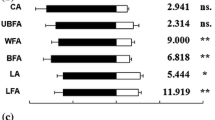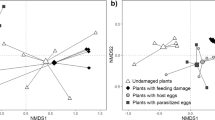Summary
Behavioral observations, preference tests, and physiological studies show thatProctolaelaps nauphoetae, an ectoparasitic mite, bases its choice of host on chemical information. Behavioral observations characterized searching patterns used to detect chemical cues. Preference tests showed that mites are attracted by three kinds of chemical cues: general cues — feces and detritus, apposite cues — cockroach expectorants, and a host-specific cue. This last cue, nauphoetamine, was isolated by gel filtration and high voltage paper electrophoresis. Preliminary analysis shows that it is a macromolecular amine (mw = 1,500–6,500) and may be a glycosaminoglycan. Electrophysiological experiments showed that nauphoetamine is detected by contact chemoreceptors located on the tarsi of the first pair of legs; these records are the first reported for a mite. The process of host discrimination is discussed in terms of a general model first proposed for hymenopteran parasites.
Similar content being viewed by others

References
Askew, R.R.: Parasitic insects. New York: American-Elsevier 1971
Baker, E.W., Wharton, G.W.: An introduction to acarology. New York: Macmillan Co. 1952
Balazs, E.A., Jeanloz, R.W. (Eds.): The amino sugars, IIB. Metabolism and interactions. New York: Academic Press 1969
Bland, K.P., Miller, G.J.: The function of the salivary gland of the cockroachN. cinerea. J. Insect Physiol.17, 2069–2083 (1971)
Camin, J.H.: Observations on the life history of the snake mite,Ophionyssus natricus. Chicago Acad. Sci. Spec. Publ.10, 1–75 (1953)
Camin, J.H.: Relations between host finding behavior and life histories in ectoparasitic acarina. In: Advances in acarology, pp. 411–424 (J. A. Naegele, ed.). Comstock Univ. Press 1963
Chow, Y.S.: Sex pheromone and behavioral studies of the gulf coast tick. Ph.D. dissertation. Auburn University (1970)
Determann, H.: Gel chromatography. Berlin-Heidelberg-New York: Springer 1968
Egan, M.E.: Small animal preference testing: design and technique. An. entomol. Soc. Amer.68, 386–387 (1975)
Egan, M.E., Barth, R.H., Hanson, F.E.: Chemically mediated host selection in a parasitic mite. Nature (Lond.)257, 788–790 (1975)
Egan, M.E., Hunter, P.: Rediscription of a cockroach mite, with notes on its biology. Ann. entomol. Soc. Amer.68, 361–364 (1975)
Egan, M.E., Moss, W.W.: The life cycle and behavior of a cockroach mite. Not. Nat. (Phila.)420, 1–9 (1969)
Elizarov, Y.A.: Insect and tick chemoreception: electrophysiological studies of the chemoreception of Ixodidae. vestnik Moskovskogo Univ. (Ser. VI), Biol. Pochvovedonie,6, 16–24 (1963) [Russian].
Fain, A.: Adaptations to parasitism in mites. Acarol.11, 450–483 (1969)
Field, L.: Cleaning and feeding in hermit crabs: a neuroethological analysis. Ph.D. dissertation. University of Oregon. (1972)
Flanders, S.E.: Variations in susceptibility of citrus-infesting coccids to parasitism. J. Econ. Entomol.46, 266–269 (1953)
Flanders, S.E.: The circumstances of species replacement among parasitic Hymenoptera. Canad. Entomol.98, 1009–1023 (1966)
Hamilton, P.B.: Ion exchange chromatography of amino acids: recent advances in analytical determinations. Advanc. Chromatog.2, 3–62 (1966)
Hays, D.B., Vinson, S.B.: Acceptance ofHeliothis virescens (F) as a host by the parasiteCardiochiles nigriceps Viereck. Anim. Behav.19, 344–352 (1971)
Illingsworth, J.F.: Notes on Hawaiian cockroaches. Proc. Haw. entomol. Soc.3, 136–140 (1915)
Lindquist, E.E.: Associations between mites and other arthropods in forest floor habitats. Canad. Entomol.107, 425–437 (1975)
McKittrick, F.A.: Evolutionary studies of cockroaches. Cornell Univ. Agr. Exp. Sta. Mem. No. 389 (1964)
Oser, B.L. (Ed.): Hawk's physiological chemistry. New York: Blakiston 1965
Radovsky, F.J.: Adaptive radiation in the Mesostigmata. Acarol.11, 450–483 (1969)
Roth, L.M., Dateo, G.P.: A sex pheromone produced by males of the cockroachNauphoeta cinerea. J. Insect Physiol.12, 255–265 (1966)
Roth, L.M., Niegish, W.D., Stahl, W.H.: Occurrence of 2-hexenal in the cockroachEurycotis floridana. Science123, 670–671 (1956)
Roth, L.M., Willis, E.: Biotic associations of cockroaches. Smith, misc. Coll., No. 141 (1960)
Rothschild, M., Ford, B.: Breeding in the rabbit flea controlled by the hormones of the host. Nature (Lond.)201, 103–104 (1964)
Salt, G.: Experimental studies in insect parasitism. III. Host selection. Proc. roy. Soc. (B)117, 413–435 (1935)
Schaefer, C.W., Peckham, D.B.: Host preference studies on a mite infesting the cockroachGromphadhorina portentosa. An. entomol. Soc. Amer.61, 1475–1478 (1968)
Sokal, R.R., Rohlf, F.J.: Biometry. San Francisco: W.H. Freeman 1969
Stahl, E., Kaltenbach, J.: Sugars and derivatives. In: Thin layer chromatography: A laboratory manual, pp. 461–469 (Stahl, ed.). Berlin-Heidelberg-New York: Springer 1965
Wicht, M.C., Rodriguez, J.G., Smith, H.J., Jalil, M.: Attractant toMacrocheles muscaedomesticae (Acarina) present in the housefly. J. Insect Physiol.17, 63–70 (1971)
Wolbarsht, M., Hanson, F.E.: Electrical activity in the chemoreceptors of the blowfly. III. Dendritic action potentials. J. gen. Physiol.48, 673–683 (1965)
Author information
Authors and Affiliations
Additional information
This research effort profitted from the several contributions of Abby Shapiro, Robert Barth, Frank Hanson, G. Barrie Kitto, Rudy Morales, Ted Hollingsworth, E.E. Lindquist, K.P. Bland, Bill Clavert, A. Gelperin, USPHS Grant No. GM 00386-07, and the faculty and staff of the Zoology Department at the University of Texas. All are greatfully acknowledged. Figures 10 and 13 are used with the permission ofNature.
Rights and permissions
About this article
Cite this article
Egan, M.E. The chemosensory bases of host discrimination in a parasitic mite. J. Comp. Physiol. 109, 69–89 (1976). https://doi.org/10.1007/BF00663436
Received:
Issue Date:
DOI: https://doi.org/10.1007/BF00663436



